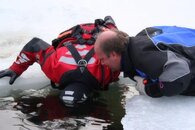With your style of diving, I just don't understand your love of piston regs. Fine with that, though. Your preference.
But I don't love piston regs! Like you rightfully said, I find them totally unsuited for my purposes. I prefer sealed diaphram regs. I like Atomics as a company because of their after sales support.
---------- Post added November 13th, 2014 at 09:32 AM ----------
Quick history lesson, the big manufacturers tend to focus on either piston or diaphragm style first stages. Apeks and Poseidon are the big boys in the Diaphragm side, neither of them make a piston first stage, Scubapro and now Atomic *bunch of ex Scubapro engineers btw* are basically all pistons. Scubapro does make the MK11, and MK17 which are diaphragm *I think these are actually a Tusa design that was adopted by SP*, but you don't see them often, the MK25 and MK2 are much more common and generally the ones you see when people think of Scubapro first stages.
Based on this information I am beginning to understand that when it comes to piston designs, the top dogs in the industry are Scubapro and their divorced cousin Atomic. When it comes to sealed Diaphram regs however, Atomic has none and Scubapro has some in their line-up but they do not specialize in diaphram designs as much as Apeks. Thus for anyone wanting to be under ice, Apeks seems to be a more logical choice. Makes sense?
---------- Post added November 13th, 2014 at 09:45 AM ----------
What is lacking in this thread is the SKILL involved in using any reg in truly cold water. Fresh water is densest at 39F (4C). Which means it sinks. The cold water is at the bottom, the water near the surface is slightly warmer. The air freezes the top layer. Sloshing around near the surface almost always erodes the ice hole. You know it is cold when the ice hole keeps freezing over. See pic.
The first skill is to embrace the conditions you are diving in. Losing a mask is quite a shock. See pic below. That is an instructor showing a student exactly how he wants the student to "kiss the water".
There is also a strict protocol on how to handle and breathe your regs, both primary and secondary. I'd be willing to take an MK25 into those conditions, did it once. Problem is you spend too much focus on babying the gear. I've converted to MK17's and G250(V)'s for everything. They cut me slack so I can just enjoy the dive. Any of the other manufacturer's top end ice regs will do exactly the same thing. BS on "I'd only dive this or that", any good ice reg will serve the recreational diver well.
View attachment 197486
Photo credit: My ice diving course, WVFA76 photographer.
When I did my ice diving course, we did all skills that are considered fundamental for ICE. These included:
1. De-tuning the regs.
2. Making sure that no one dry-breathes the regulator on surface.
3. Using sealed diaphram designs
In spite of the above, my sealed diaphram (Apeks XTX 50) began to leak when it was turned on.Hell it had not even seen the water when the first stage began to hiss. Mine was not the only reg. Most regulators that day were acting up though the above precautions were taken. After this I contacted Sven from Northern Explorers who does Arctic diving. I asked him what brands / gear handling procedures he uses for his Arctic dives. His reply was that all regulators act up regardless of brand / make and SKILLS. This is his reply:
Hi,
the Mares (Abyss Navy 2) is great. We did not find any reg. which did not freeze, so far.... including the Abyss and the Apeks. All regulators seems to be a good choice for cold water. Also Poseidon and Beuchat would work. I dive these two brands, currently and had an Abyss before.
The Abyss is just a bit heavy stuff. Poseidon has a nice and small 2. stage.
Apeks is used a lot for tech. diving here, so seems it can cope with extreme conditions.
Hope this helps - even if it is not just one brand which I can recommend. I think the truth is that nearly all high end products are okay - however, when diving very cold water below zero, every reg. has problems. Also the quality of the air and how much you breath will have influence.
BR Sven




